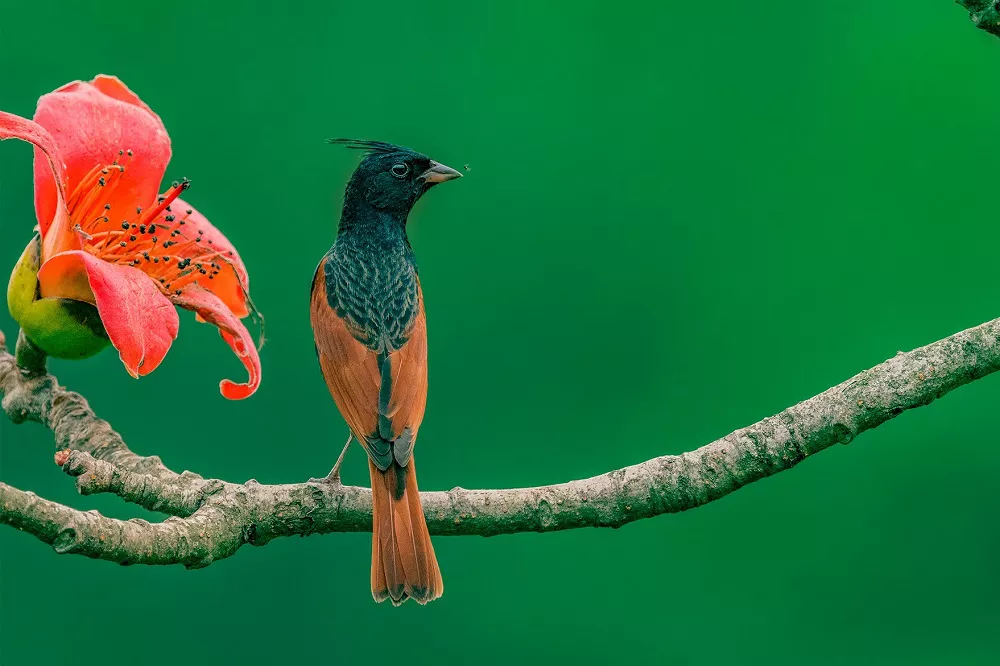The Crested Bunting, scientifically known as Emberiza lathami, is a captivating passerine bird species that has fascinated ornithologists and birdwatchers worldwide. With its distinct and striking features, the Crested Bunting stands out amidst its avian counterparts. In this article, we will delve into the appearance of the Crested Bunting, exploring its physical characteristics, coloration, and notable traits.
Physical Characteristics
Crested Buntings are small-sized birds, with males typically measuring between 16-18 cm in length and weighing around 25-30 g. Females are slightly smaller, measuring around 14-16 cm in length and weighing around 20-25 g. They have a relatively short tail and a compact, round body shape.
Sexual Dimorphism: Male vs Female Crested Bunting
The Crested Bunting’s most distinguishing feature is its striking crested head. The crest is made up of several long, black feathers that form a plume on the bird’s head. The rest of the bird’s body is a combination of bright colors, with the male’s plumage being more vibrant than that of the female. The male has a red-orange breast and underparts, a black back, wings, and tail, and a white belly. The female has a more subdued plumage, with a brownish-grey back and wings, a pale belly, and a streaked breast.
Crested Bunting’s Tail Feathers
One of the most intriguing features of the Crested Bunting is its unique tail feathers. The central tail feathers boast a deep, glossy black color that stands out against the contrasting white outer feathers. During courtship displays, the male Crested Bunting fans its tail, creating a mesmerizing visual spectacle. This elaborate tail-feather display serves as an essential component of the male’s courtship ritual, enticing potential mates and displaying his vigor and genetic fitness.
Behavior
Crested Buntings are primarily ground-dwelling birds, found in open grasslands, cultivated areas, and scrublands. They are known for their distinctive and melodious song, which they use to attract mates and defend their territory. Crested Buntings are generally monogamous and form strong bonds with their mates, which can last for several years.
Diet
Crested Buntings are omnivorous, feeding on a variety of seeds, insects, and other small invertebrates. During the breeding season, they primarily feed on insects to provide their young with the protein they need to grow and develop. They are known to forage on the ground, often in small flocks, and occasionally on low shrubs and trees.
Conservation
The Crested Bunting is widely distributed throughout its range, which includes parts of Central Asia, India, and China. While the global population is believed to be stable, local populations in some areas have declined due to habitat loss and degradation. In China, the bird is hunted for its meat and is considered a delicacy in some regions. Efforts are being made to conserve the species, including habitat restoration and protection, as well as regulation of hunting and trade.
Some Interesting Facts About Crested Bunting
Here are some interesting facts about the Crested Bunting:
1. Range and Distribution: The Crested Bunting is native to a vast area, primarily found in parts of East Asia. Its range spans across China, Japan, Korea, Mongolia, and parts of Russia. During the breeding season, these birds inhabit grasslands, open woodlands, and shrubby areas.
See Also: What is the Crested Bunting Habitat?
2. Distinctive Crest: As the name suggests, the Crested Bunting derives its name from the prominent crest on the top of its head. This crest is a distinguishing feature, especially in males, which they display prominently during courtship displays to attract females.
3. Migratory Behavior: The Crested Bunting is known for its migratory habits. During the winter months, when the weather becomes harsh in its breeding range, the bird undertakes extensive seasonal migrations to warmer regions for survival.
4. Colorful Plumage: The Crested Bunting boasts a vibrant and eye-catching plumage. Males exhibit more vivid and striking colors than females. The intricate mix of warm cinnamon, orange, and gray tones on their bodies creates a visually stunning appearance.
5. Melodious Songs: The male Crested Bunting is renowned for its melodious and complex song. During the breeding season, they sing from elevated perches to establish territories and attract mates. Their melodious tunes add a delightful charm to the natural soundscape.
6. Omnivorous Diet: The Crested Bunting is an omnivore, meaning it consumes a diverse diet. While its primary food source consists of seeds, grains, and other plant matter, it also supplements its diet with small insects and invertebrates during the breeding season.
7. Breeding and Nesting Habits: Crested Buntings are monogamous during the breeding season, forming pairs that work together to build nests. These nests are constructed in dense vegetation or shrubs to provide protection and concealment for their eggs and nestlings.
8. Conservation Status: The Crested Bunting is listed as a species of “Least Concern” on the IUCN Red List, which means that it is not currently considered at significant risk of extinction. However, like many bird species, it faces threats from habitat loss and degradation due to human activities.
9. Nomadic Movements: Outside of the breeding season, Crested Buntings exhibit nomadic tendencies, wandering in search of food and suitable habitats. This nomadic behavior helps them cope with changing environmental conditions and resource availability.
Conclusion
In conclusion, the Crested Bunting is a remarkable bird that captivates observers with its vibrant plumage, distinctive features, and enchanting behaviors. Its physical characteristics, including the prominent crest atop its head, make it instantly recognizable. The striking coloration of the male and female birds adds to their allure, while their melodious songs and courtship displays showcase their unique behaviors. However, the Crested Bunting also faces conservation challenges, emphasizing the need for concerted efforts to protect its habitats and ensure its survival for future generations to admire. By appreciating and understanding the beauty of the Crested Bunting, we can contribute to the conservation of this enigmatic species and preserve the wonders of our natural world.


 Facebook
Facebook  Instagram
Instagram  Youtube
Youtube 